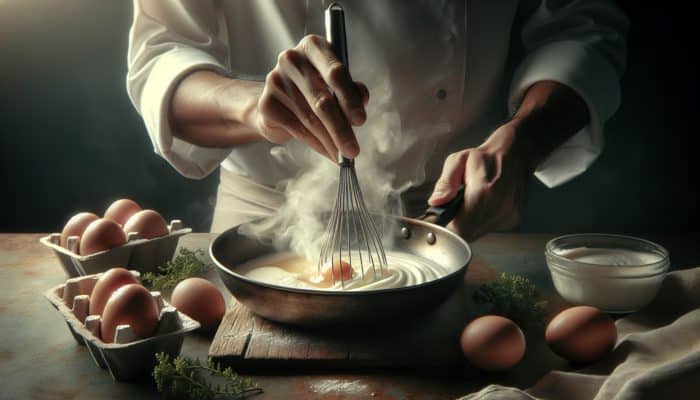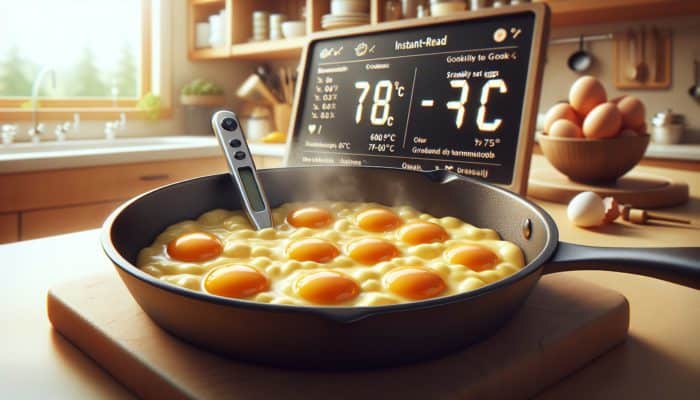Master the Art of Scrambled Eggs: Your Ultimate Guide to Perfection
How to Choose the Finest Eggs for Exceptional Scrambled Eggs

Selecting fresh, high-quality eggs is essential for creating the most delectable scrambled eggs imaginable. The cornerstone of any egg-based dish lies in the quality of the eggs you select. Seek out eggs that feature clean, uncracked shells and a vibrant, firm yolk, as these characteristics are key indicators of freshness. Choosing free-range and organic eggs not only results in more colourful yolks but also hints at a richer and more intricate flavour profile. The size of the eggs can also impact your dish; medium or large eggs are generally the preferred choice for scrambling, as they provide an ideal balance of yolk and white that contributes to the overall texture and taste.
When shopping for eggs, consider sourcing them from local farms or reputable suppliers. This practice not only supports local agriculture but often yields fresher products that are superior in quality. Fresh eggs typically have a firmer white and a perfectly rounded yolk that retains its shape, culminating in fluffier and visually appealing scrambled eggs. Always check the sell-by date on the carton, as eggs that are past their prime may not deliver the desired results in your culinary creations. Taking the time to select the right eggs is an indispensable first step toward achieving culinary excellence in your cooking journey.
Essential Kitchen Equipment for Crafting Fluffy Scrambled Eggs
Creating perfectly fluffy scrambled eggs requires the right kitchen tools, making them indispensable for any home cook. A high-quality non-stick pan is a must-have for this task, as it prevents the eggs from sticking, allowing for easy flipping and stirring. A well-constructed non-stick pan significantly enhances your cooking experience by ensuring even cooking and a smooth release of the eggs when they are done. Pair this essential tool with a silicone spatula, which is gentle on your cookware and allows you to scrape the pan without causing damage to its surface.
In addition to these core tools, consider using a whisk or fork for beating the eggs. This method introduces air into the mixture, resulting in a light and fluffy texture that delights the palate. A mixing bowl, preferably one that is easy to pour from, is also useful for seamlessly combining all the ingredients. Finally, having a thermometer on hand can help you monitor the cooking temperature accurately, further enhancing the quality of your scrambled eggs and ensuring they are cooked to perfection.
The Importance of Understanding Egg Composition for Perfect Scrambled Eggs
Grasping the composition of eggs is fundamental for mastering the art of scrambled eggs. Eggs are primarily made up of water, protein, and fat. The water content is crucial for generating steam during the cooking process, which contributes to a lighter and fluffier texture in your scrambled eggs. Meanwhile, the proteins in the egg whites coagulate and provide essential structure, while the yolk adds richness and creaminess due to its fat content. Understanding how to balance these components is the key to achieving the desired outcome in your scrambled eggs.
The interaction between these elements becomes even more significant during the cooking process. For instance, when heat is applied, the proteins begin to denature and coagulate. If eggs are cooked too quickly or at excessively high temperatures, the proteins can become tough, resulting in dry, rubbery eggs. Therefore, understanding egg composition empowers you to control the cooking process more effectively, ensuring that each component contributes to a harmonious and delectable scrambled egg dish that meets your expectations.
Expert Techniques for Crafting Creamy Scrambled Eggs

How to Control Heat for Creamy Scrambled Eggs
Effective heat control is paramount for achieving creamy scrambled eggs. The temperature at which you cook your eggs can significantly affect their texture and flavour. It is advisable to use low to medium heat, as this prevents overcooking and ensures even cooking throughout the dish. Cooking on high heat may cause the exterior to cook too quickly while leaving the inside undercooked, leading to an undesirable outcome that can compromise your breakfast experience.
As you refine your heat control skills, consider implementing these tips for optimal results:
- Start with a cold pan; allow the pan to gradually heat with the eggs included.
- Adjust the heat as necessary; if the eggs begin to sizzle or bubble, lower the temperature accordingly.
- Use a lid intermittently to trap steam, promoting more even cooking throughout the mixture.
- Remove the pan from heat just before the eggs are fully set to allow for carryover cooking, resulting in the perfect texture.
By applying these heat control tips, you can consistently achieve scrambled eggs that are creamy and rich in flavour, significantly enhancing your breakfast experience and delighting your taste buds.
How Timing and Stirring Techniques Influence Your Scrambled Eggs
The timing and frequency of stirring during the cooking process have a profound impact on the texture of your scrambled eggs. Constant stirring encourages smaller curds, resulting in a softer texture, while less frequent stirring can lead to larger, firmer curds. Striking a balance between the two is often ideal for achieving the perfect scramble that everyone desires.
To master this technique, start by gently pouring the beaten eggs into your preheated pan. Use your spatula to stir continuously, adopting a figure-eight motion to ensure even cooking. Timing is crucial; as soon as the eggs begin to set, reduce the frequency of stirring to allow larger curds to form. This method will provide a delightful mix of creamy and fluffy textures in each bite, enhancing the overall experience of enjoying your scrambled eggs.
What Is the Optimal Cooking Temperature for Perfect Scrambled Eggs?

The ideal temperature for scrambled eggs is approximately 70-75°C. Cooking at this temperature allows the eggs to cook slowly and gently, preserving their moisture and tenderness. At this range, the proteins in the eggs coagulate perfectly without becoming rubbery, resulting in a light, fluffy texture that any egg lover will appreciate.
To achieve this temperature, using an instant-read thermometer can be extremely beneficial. Insert the thermometer into the centre of the eggs to monitor the heat accurately. If a thermometer is unavailable, keep an eye on the appearance of the eggs—they should be softly set with a glossy sheen, indicating that they are nearly ready. Practising this method will enable you to produce scrambled eggs that are consistently delightful and satisfying to enjoy.
Why Resting Eggs Is Crucial for Achieving Optimal Texture
Allowing scrambled eggs to rest off the heat is a critical step that is often overlooked. This technique permits the eggs to finish cooking gently, ensuring they remain moist and tender. Resting allows the residual heat to work through the eggs, setting them without further cooking, which can lead to dryness and disappointment in your dish.
To incorporate this step, simply remove the pan from the heat just before the eggs are fully cooked. Transfer the mixture to a warm plate or bowl and cover it lightly with foil to retain heat. Allowing the eggs to rest for a minute or two will significantly elevate their texture, transforming your dish from ordinary to extraordinary. Mastering this crucial step will undoubtedly enhance the overall quality of your scrambled eggs, impressing your family and friends alike.
Choosing the Ideal Pan for Perfect Scrambled Eggs
The type of pan you select can greatly influence the cooking process for your scrambled eggs. A non-stick pan is the ideal choice, as it prevents sticking and allows for smooth stirring and easy removal of the eggs. The material and size of the pan also play a critical role in heat distribution; a heavy-bottomed pan retains heat well, ensuring even cooking that is essential for perfect scrambled eggs.
Opt for a pan that features sloped sides, as this design facilitates easy access for stirring and flipping. Additionally, take into account the size of your pan; using one that is too small can overcrowd the eggs, leading to uneven cooking. Conversely, a pan that is too large will spread the eggs too thinly, causing them to dry out. Selecting the right pan tailored to your cooking needs is essential for achieving perfect scrambled eggs that delight the palate and satisfy the senses.
Enhancing Flavours and Textures in Your Scrambled Eggs
How to Incorporate Fresh Herbs and Spices for Superior Flavour
Boosting the flavour of scrambled eggs with herbs and spices can elevate this simple dish into a culinary delight that excites the taste buds. Fresh herbs such as chives, dill, or parsley can add a burst of flavour and vibrant colour, making your meal visually appealing as well. Spices like paprika or black pepper can provide a delightful kick that contrasts beautifully with the creaminess of the eggs.
Timing is crucial when adding these flavour-enhancing ingredients. Incorporate delicate herbs right at the end of cooking to preserve their fresh taste and vibrant colour. For more robust herbs and spices, adding them a minute or two earlier allows their flavours to meld beautifully with the eggs. This thoughtful approach to seasoning will result in a layered and harmonious dish, making each bite an experience worth savouring.
Using Dairy and Fats to Achieve Unmatched Creaminess in Scrambled Eggs
Incorporating dairy products such as milk, cream, or butter into your scrambled eggs can add richness and depth to the dish, enhancing both flavour and texture. These ingredients not only elevate flavour but also contribute to achieving that desirable creamy texture that everyone loves. The fat content in dairy helps emulsify the eggs, resulting in a luscious mouthfeel that significantly enhances your scrambled eggs.
When adding dairy, use it sparingly—just a splash of milk or cream mixed into the eggs before cooking can work wonders. Butter should be added to the pan before the eggs, allowing it to melt and coat the surface. This not only enhances the flavour but also prevents sticking, ensuring your eggs slide out effortlessly. Experimenting with different types and amounts of dairy will help you discover your perfect scramble that suits your personal taste preferences.
What Crunchy Ingredients Can You Incorporate into Your Scrambled Eggs?
Introducing crunch to your scrambled eggs can create an exciting textural contrast, making your breakfast more satisfying and enjoyable. Ingredients such as chopped nuts, crispy bacon, or even sautéed vegetables can provide that delightful crunch that enhances the overall dish. These elements should be added just before serving to preserve their crispness and elevate your scrambled eggs.
For instance, crispy bacon can be chopped and sprinkled over the top, or toasted pine nuts can be added for a nutty flavour and satisfying crunch. Sautéed onions or bell peppers can also be incorporated for a wholesome crunch. The key is to balance these crunchy elements with the creaminess of the scrambled eggs, resulting in a well-rounded dish that excites the palate and transforms breakfast into an extraordinary experience.
Common Pitfalls to Avoid When Preparing Scrambled Eggs
How to Prevent Overcooking Your Scrambled Eggs Effectively
Overcooking is perhaps the most common mistake made when preparing scrambled eggs, leading to dry, rubbery results that are far from appetising. The key to avoiding this pitfall is to remove the eggs from the heat while they are still slightly underdone. They will continue to cook from residual heat as they rest, achieving the perfect consistency without losing moisture.
To prevent overcooking, keep a close eye on the cooking process. Stir the eggs continuously and remain attentive to their appearance. As soon as they begin to set, remove them from the heat immediately. This simple technique will ensure your scrambled eggs remain soft, creamy, and delicious, creating a breakfast that is not only visually appealing but also enjoyable to eat.
How Does Choosing the Right Pan Influence Scrambled Eggs?
Using an unsuitable pan can significantly hinder your ability to achieve perfect scrambled eggs. A non-stick pan is essential for preventing the eggs from sticking and ensuring they cook evenly. Standard pans may cause the eggs to adhere to the surface, resulting in a mess and uneven cooking that can ruin your breakfast experience.
Investing in a quality non-stick pan specifically designed for cooking eggs can yield excellent results. When using the right pan, ensure it is preheated and adequately greased with butter or oil to further prevent sticking. By selecting appropriate cookware, you set yourself up for success in creating delightful scrambled eggs that are both aesthetically pleasing and delicious.
What Are the Effects of Salt Timing on Scrambled Eggs?
The timing of when you add salt to your scrambled eggs can dramatically alter their texture and quality. Adding salt too early can break down the proteins in the eggs, leading to watery scrambled eggs that lack the desired richness and fluffiness. Instead, it’s best to add salt just before or after cooking to preserve the integrity of the proteins and ensure a delightful outcome.
Experimenting with salt timing can yield different results. For a deeper flavour, adding a pinch of salt to the beaten eggs can season them beautifully without compromising texture. However, salting them in the pan while cooking can draw out moisture, resulting in an undesirable consistency. Mastering the timing of salt addition is a crucial step in perfecting your scrambled eggs and achieving that restaurant-quality taste at home.
Why Is Continuous Stirring Vital for Perfect Scrambled Eggs?
Neglecting to stir the eggs continuously can result in uneven cooking and large, rubbery curds that are far from ideal. For the best texture, maintain a gentle stirring motion throughout the cooking process. Continuous movement of the eggs ensures they cook uniformly, creating a soft and creamy consistency that everyone desires.
Adopting a methodical approach to stirring can significantly enhance your final dish. Use a silicone spatula for a gentle touch, and stir in a figure-eight motion, ensuring you reach the edges of the pan. Maintaining a consistent stirring rhythm allows for even heat distribution, leading to a delightful and creamy scramble that will impress anyone at the breakfast table.
How Does Using Room Temperature Ingredients Affect Scrambled Eggs?
Starting with cold eggs and milk can dramatically lower the pan's temperature, causing the eggs to cook unevenly, resulting in a less than desirable scrambled egg dish. For optimal results, use room temperature ingredients. This simple tip can help achieve a smoother and more cohesive texture in your scrambled eggs.
To prepare, take the eggs out of the refrigerator at least 30 minutes before cooking. For milk or cream, ensure it also reaches room temperature. By allowing your ingredients to come to temperature, you can ensure a quicker and more consistent cooking process, allowing for a perfect scramble every time that will leave you wanting more.
Research-Backed Advantages of Techniques for Perfect Scrambled Eggs
The Nutritional Benefits of Including Scrambled Eggs in Your Diet
Scrambled eggs are not only a delicious breakfast option, but they also boast impressive nutritional benefits that can support your overall health. Eggs are an excellent source of protein, vitamins, and minerals, including Vitamin D, choline, and selenium. These nutrients contribute to overall health and well-being, making scrambled eggs a nutritious choice for any meal of the day.
Incorporating scrambled eggs into your diet provides essential amino acids that support muscle development and repair. Furthermore, they are relatively low in calories, making them an ideal addition to a balanced diet. The versatility of scrambled eggs means they can be tailored to personal taste, adding various ingredients to enhance their nutritional profile and make them even healthier.
How Do Scrambled Eggs Influence Satiety and Weight Management?
Scrambled eggs have a profound impact on satiety due to their high protein content. Consuming a protein-rich breakfast can lead to increased feelings of fullness, which may help regulate hunger throughout the day. This can be particularly beneficial for those aiming to manage their weight or reduce snacking between meals, making scrambled eggs a smart breakfast choice.
Research suggests that incorporating protein into breakfast can enhance overall dietary adherence and improve energy levels. The combination of protein and healthy fats in scrambled eggs provides sustained energy, helping to keep you satisfied longer. Whether enjoyed in a traditional manner or with creative additions, scrambled eggs can play a crucial role in a balanced breakfast routine that fuels your day.
How Do Scrambled Eggs Contribute to Overall Health and Well-Being?
Regular consumption of scrambled eggs can contribute positively to a balanced diet. They are rich in essential nutrients that support overall health and well-being. Eating eggs as part of a varied diet can help maintain energy levels and promote optimal physical and mental function, making them a valuable addition to your meals.
- Rich source of high-quality protein that supports muscle recovery.
- Provides essential vitamins and minerals necessary for various bodily functions.
- Supports muscle repair and growth, especially post-exercise.
- Contributes to healthy brain function, enhancing cognitive abilities.
- Helps maintain healthy skin and eyes, contributing to overall wellness.
In addition to their nutritional content, the versatility of scrambled eggs allows them to be incorporated into various recipes, ensuring that they remain a staple in healthy eating practices.
How Do Scrambled Eggs Affect Cognitive Function and Brain Health?
Scrambled eggs contain choline, a vital nutrient for brain health. Choline is essential for the production of neurotransmitters that play a crucial role in memory and cognitive function. Regular consumption of scrambled eggs can support brain health, enhancing memory and cognitive capabilities, which is particularly important as we age.
Incorporating eggs into your diet helps ensure that you meet your daily recommended intake of choline. The rich nutrient profile of scrambled eggs makes them an excellent addition to breakfast, providing not only energy but also vital support for cognitive function throughout the day, keeping your mind sharp and focused.
What Is the Role of Scrambled Eggs in Muscle Recovery and Growth?
The high protein content in scrambled eggs is particularly beneficial for muscle repair and growth, making them an ideal post-workout meal. Consuming protein-rich foods after exercise aids in muscle recovery, helping to replenish and build muscle tissues effectively. Scrambled eggs can serve as a delicious and convenient option for those looking to optimise their recovery and performance.
Furthermore, the combination of protein and healthy fats found in scrambled eggs provides sustained energy, making them a perfect choice for athletes and fitness enthusiasts. Whether consumed alone or paired with other nutritious ingredients, scrambled eggs can support your fitness goals while delivering a tasty experience that is both satisfying and nourishing.
Discovering Unique Variations and Recipes for Scrambled Eggs
What Unique Scrambled Egg Recipes Can You Experiment With?
Experimenting with different ingredients can lead to exciting scrambled egg dishes that break the monotony of breakfast. Consider incorporating a variety of cheeses, such as feta, cheddar, or goat cheese, to enhance the flavour and richness of your eggs. Adding vegetables like spinach, tomatoes, or bell peppers can provide colour and boost the nutritional value of your dish.
For a twist, try international variations like shakshuka, where eggs are poached in a spiced tomato sauce, or huevos rancheros, featuring eggs served on tortillas with beans and salsa. The possibilities are endless; you can even explore fusion dishes by incorporating Asian flavours, such as sesame oil and green onions, for a unique breakfast experience. With creativity and a willingness to experiment, you can transform traditional scrambled eggs into an exciting culinary adventure that delights the senses.
Incorporating Leftover Ingredients into Your Scrambled Eggs
Leftover vegetables, meats, or grains can be creatively incorporated into scrambled eggs for a quick and delicious meal that helps minimise waste. This approach not only adds flavour and texture to your scramble but also makes use of ingredients that might otherwise go unused. For instance, leftover roasted vegetables can provide a hearty base, while diced meats like ham or chicken can add protein-rich substance.
To make the most of your leftovers, sauté them briefly before adding the eggs, allowing the flavours to meld beautifully before incorporating the main ingredient. This method creates a satisfying and nutritious dish that transforms leftover ingredients into a delightful breakfast or brunch option. By utilising what you have on hand, you can create unique scrambled egg variations that are both economical and delicious, making your cooking experience more enjoyable.
How to Create Scrumptious Scrambled Egg Omelettes?
Scrambled egg omelettes combine the fluffiness of scrambled eggs with the structure of an omelette, resulting in a versatile dish that is perfect for breakfast or brunch. To create a scrambled egg omelette, start by whisking your eggs with a touch of milk or cream for added richness. Heat your non-stick pan and pour in the egg mixture.
As the eggs begin to set, gently push the cooked edges towards the centre while tilting the pan to allow the uncooked eggs to flow to the edges. This technique creates a fluffy texture that is satisfying to eat. Once the eggs are nearly cooked but still slightly runny, add your desired fillings, such as cheese, vegetables, or meats. Fold the omelette in half and let it sit for another minute to finish cooking. This method results in a beautifully fluffy scrambled egg omelette that is both satisfying and delicious.
Effective Serving and Presentation Techniques for Scrambled Eggs
Creative Plating Ideas to Enhance Your Scrambled Eggs
Arranging scrambled eggs attractively on a plate can significantly enhance the dining experience. Presentation plays a crucial role in how we perceive food, and a well-plated dish can transform even the simplest meal into something special. Consider using colourful garnishes, such as fresh herbs or a sprinkle of paprika, to elevate the visual appeal of your scrambled eggs.
In addition to garnishing, consider the shape and colour of your plate. A white or brightly coloured plate can provide a beautiful contrast against the golden hue of the eggs, making them stand out. Layering the eggs with other ingredients, such as sautéed vegetables or crispy bacon, can add depth and dimension to the presentation, transforming your dish into something not only delicious but also visually stunning and tempting.
Selecting the Best Accompaniments for Your Scrambled Eggs
Choosing the right accompaniments can beautifully complement scrambled eggs, resulting in a well-rounded meal. Toast, fruit, or a light side salad can create a balanced and satisfying breakfast experience. For example, a slice of buttery toast enhances the overall experience and provides a delicious vehicle for the creamy eggs. Fresh fruit adds a refreshing contrast, while a light side salad can introduce a crunch and balance the richness of the eggs.
When selecting accompaniments, consider flavour harmony and contrasting textures. Pairing scrambled eggs with crispy bacon or sausage can provide a satisfying crunch, while a dollop of salsa or avocado can introduce a creamy element. Thoughtfully chosen accompaniments elevate your scrambled eggs into a well-rounded dining experience that pleases both the palate and the eye.
How to Keep Scrambled Eggs Warm Without Overcooking Them?
Keeping scrambled eggs warm without overcooking them can be a challenge when preparing breakfast for a crowd. To maintain their temperature without continuing to cook the eggs, consider using a double boiler method. Place a heatproof bowl over a pot of simmering water, ensuring the bottom of the bowl doesn't touch the water. This gentle, indirect heat will keep your eggs warm and fluffy without any further cooking.
Alternatively, serving the eggs on a warm plate or covering them with foil can also help retain heat effectively. The goal is to prevent the eggs from cooling too quickly while avoiding further cooking that can lead to dryness. Mastering this technique is crucial for maintaining the quality of your scrambled eggs right up until serving.
Storing and Reheating Scrambled Eggs Effectively
Proper Storage Techniques for Leftover Scrambled Eggs
Storing scrambled eggs properly is essential for maintaining freshness and quality. Transfer any leftover scrambled eggs into an airtight container and place them in the refrigerator. When stored correctly, scrambled eggs can last up to four days, allowing for convenient meals throughout the week.
For optimal storage, ensure the eggs have cooled to room temperature before sealing them in the container. This precaution helps prevent moisture buildup, which can affect texture and flavour. When reheating, aim to restore their original creamy consistency without overcooking, ensuring a delightful experience upon serving that will remind you of the freshly made dish.
Effective Reheating Techniques for Scrambled Eggs
Reheating scrambled eggs requires care to avoid overcooking, which can ruin the texture and flavour. The goal is to gently raise the temperature without drying them out. Consider using a low heat setting on the stove while stirring frequently to evenly warm the eggs. Alternatively, you can use a microwave on medium power, reheating in short intervals of 30 seconds and stirring in between to ensure even warming.
By taking the time to reheat scrambled eggs properly, you can enjoy a meal that tastes just as good as when it was first prepared. This attention to detail not only preserves the flavour but also enhances the overall dining experience, allowing you to relish every delicious bite.
Can You Freeze Scrambled Eggs for Future Use?
Yes, you can freeze scrambled eggs for up to three months, making them a convenient option for meal prep. To do so, allow the scrambled eggs to cool completely, then portion them into airtight containers or freezer bags. This method ensures easy reheating and use, allowing you to enjoy scrambled eggs at your convenience without compromising on quality.
When reheating frozen scrambled eggs, thaw them in the refrigerator overnight before warming them gently on the stovetop or in the microwave. This careful approach helps maintain their texture and flavour, ensuring you enjoy a tasty meal even after freezing, making scrambled eggs a versatile dish that can be enjoyed anytime.
Safety Guidelines for Storing and Reheating Scrambled Eggs
To ensure food safety when storing and reheating scrambled eggs, always allow them to cool before sealing them in an airtight container. This step prevents bacterial growth, ensuring your meal remains safe to eat. When reheating, ensure the eggs reach an internal temperature of at least 74°C to guarantee they are safe for consumption, providing peace of mind while enjoying your delicious dish.
By following these safety guidelines, you can enjoy your scrambled eggs without compromising on quality or safety. Proper storage and reheating practices will ensure that your delicious creation remains as enjoyable the next time you serve it, making your scrambled eggs a reliable choice for any meal.
Frequently Asked Questions About Scrambled Eggs
What is the best type of pan for cooking scrambled eggs?
The best type of pan for scrambled eggs is a non-stick skillet. It allows for easy stirring and prevents the eggs from sticking, ensuring even cooking for a perfect scramble that everyone will savour.
How long should you typically cook scrambled eggs?
Scrambled eggs typically take about 5 to 7 minutes to cook on low to medium heat. It's important to stir continuously for even cooking and to achieve that creamy texture.
Can I add cheese to my scrambled eggs for extra flavour?
Yes, incorporating cheese into scrambled eggs enhances flavour and creaminess. Add cheese just before the eggs finish cooking for optimal meltiness and that delicious cheesy goodness.
What herbs work best with scrambled eggs?
Fresh herbs like chives, dill, and parsley pair beautifully with scrambled eggs. Add them towards the end of cooking to maintain their vibrant flavour and colour, enhancing your dish.
How can I make my scrambled eggs fluffier?
To make scrambled eggs fluffier, whisk them well before cooking, and include a splash of milk or cream. Cooking over low heat while stirring continuously also helps achieve a fluffy texture that everyone loves.
Is it safe to eat leftover scrambled eggs?
Yes, scrambled eggs can be safely stored in an airtight container in the refrigerator for up to four days. Ensure they are reheated to at least 74°C before consumption to enjoy them safely.
What’s the ideal cooking temperature for scrambled eggs?
The ideal cooking temperature for scrambled eggs is around 70-75°C. This gentle heat preserves moisture and tenderness without overcooking, resulting in a delightful dish.
Can I freeze scrambled eggs for later use?
Yes, scrambled eggs can be frozen for up to three months. Cool them completely and store in portion-sized containers for convenient reheating at any time.
How do I prevent scrambled eggs from becoming dry?
To prevent dryness, remove scrambled eggs from heat while they are still slightly undercooked. They will continue to cook from residual heat during resting, ensuring a soft and creamy texture.
What is the best way to reheat scrambled eggs without losing quality?
The best way to reheat scrambled eggs is on low heat on the stovetop, stirring frequently. Alternatively, use a microwave in short intervals to warm gently without overcooking, preserving their delightful taste.
Connect with us on Facebook!
The post Techniques for Perfect Scrambled Eggs: Master the Art appeared first on https://cookinggods.com
The Article Perfect Scrambled Eggs: Master Essential Cooking Techniques Was Found On https://limitsofstrategy.com

